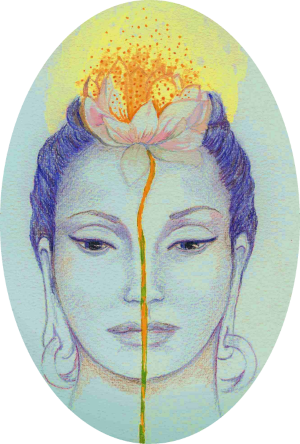We have looked, so far, at faith, the concept of 'flow' and the reality and
limits of our control over events. Here we are looking at the concepts of
'seeking' and 'knowing'.
Yogins are seekers ~ seekers of a deeper and less accessible Self than the
self constructed by the ego over a lifetime. Yoga has never been the quest
for longevity, but it is the quest for eternity which takes us on an inward
journey. However, we are accustomed to journeys having a destination. On
our inner journey, how do we know when we have reached the destination? Is
there one?
In the Kena Upanishad ~ one of the ten principal Upanishads ~ the question
'how we know' and 'how we know that we know' is raised. The first chapter
is a dialogue between seekers and teacher ~ the word kena means 'by what
agency' or 'by whom'. The question the Upanishad opens with is: 'By what
agency, or by whom, is our quest directed towards an external object?'
Very few of us are born as seekers of that inner reality that transcends
this world of subject/object. We are born and immediately our senses reach
outward, we seek out the objects of the world to give us fulfilment. If the
ultimate aim of life is to know that inner truth, why is this so?
The teacher addresses this question in that first chapter and by the end of
it he is making it clear that that inner reality cannot be conceived by the mind,
just as it cannot be seen by the eye.
Mystics from all over the world and from varying traditions, seem to echo
this truth ~ even modern mystics like the Anglo-Catholic mystic Evelyn Underhill
quoted above: you cannot know that truth by the same means that you know
this world.
How then do we know it, and how do we know when we know?
Seeking the Seeker
By the second chapter, the Kena Upanishad gets even more enigmatic. The teacher/seeker dialogue seems to be interrupted by the Upanishad which speaks to us directly and says:
yadi manyase suvedeti daharamevāpi var dabhramevāpi
nūnaṃ tvaṃ vettha brahmaṇo rūpam .
yadasya tvaṃ yadasya deveṣvatha nu
mīmām̐ syameva te manye viditam .. 2
If you think: "I know Brahman," then know that you do not know, because
what you know is only a form conditioned by the human mind. Therefore
Brahman, even now and always, is worthy of your inquiry.
So, even when we think we know, the Mystery is still to be revealed.
Nature reveals herself to those who would seek her out. The scientist
questions: s/he looks at the phenomena of nature and in seeking to
understand, goes on a journey of measurement. It is measurement that can be
verified ~ or dismissed ~ by other like-minded seekers.
Brahman ~ that inner truth, the 'ground of being' as the 19th century
seeker, Paul Tillich, called it ~ cannot be measured. Yet, it is the
essence, the ground of all that can be measured and all that will seek to
measure. However, when ~ as Yogins ~ we turn our attention from seeking the
measurable and go on the quest to discover/uncover the immeasurable, we can
never know when or if we have reached the destination, the Upanishad seems
to be saying.
Living with the Paradox
Days before his death the American novelist F. Scott Fitzgerald remarked to the effect
that, ‘I fear I will die soon as I am no longer able to hold two contradictory truths
in my head at one time.’ The dictionary defines a paradox as a situation or statement
that is contradictory but true. As Fitzgerald intuited, living with a paradox is to live an
awakened life, the antithesis of death. Every sincere spiritual seeker eventually comes up
against The Paradox: I will not know when I know.
We are inundated now by those who tell us ~ through multiple media ~ that they
‘know’. Whenever I hear someone expressing their knowing, I remember the great
Abhinavagupta, who said, “Pure Awareness, having adopted Maya… appears as
the finite subject. …Cloaked in six sheaths of which one is maya,
Siva says, ‘I know only now and just this much of it quite
completely’.”
The Yogins Seeking
In the Yoga tradition flesh and blood is not a denial of That ~ the Ground of Being, and
neither is it something to be discarded when That is found. Rather, the body is as much the
unfolding of the spirit as consciousness. The world may be that Divine Mystery ~ Brahman ~
with the eye of wisdom closed, but it is That nonetheless. Thus, our sense of compassion,
our love, our struggle for restoration of the Divine, has to include and embrace the
restoration of the flesh. We cannot seek to elevate the spirit at the expense of the body ~
which embodies the Divine.
We walk uncomfortably with this paradox ~ as the Katha Upanishad puts it, ‘a path
as narrow and sharp as a razor’s edge.3’ The path is not always
clearly marked ~ we have to find our way in the same manner as a migrating bird does
crossing an open sky.
Why is that so? Because the ‘I’ that knows and measures this world, cannot live
with the knowing of that which transcends it. That ‘I’ can never know, it can
only surrender. When we embrace this paradox we are walking the razor’s edge. And
only from that place are we alive enough to be able to discern that not only are we all,
regardless of our position, religion, class, social status, One Being ~ and that even our
differences are a continuum of That ~ but knowing that, is a different knowing
entirely.
Then, even our asana becomes the path: it is not the perfection of striking a pose, or the
length and strength gained in a muscle, that counts ~ but the opening of an inner path to
enquiry. Then our pranayama does not become ‘health and wellbeing’ breathing
tasks, but a quest for something unknown, or as the Katha Upanishad puts it,
‘… the source of all that lives and causes the breath to
flow4.’

“What then happened to Nachiketas? … This teaching, given by Yama, took Nachiketas through the final Yoga to merge with the Self. Not only Nachiketas, but all those who choose the path that Nachiketas chose, attain the Self.6”

Resources :
- ‘Mysticism’ by Evelyn Underhill; publ. by New York:Dutton, 1911.
- Kena Upaniṣad 2:1
- Katha Upaniṣad 3:14
- ‘Paramathasara ~ Essence of Reality’ 1.16 & 17 by Abhinavagupta ,
- Katha Upaniṣad 5:5
- Katha Upaniṣad 6:18
©Swami
Ambikananda, September 2022


